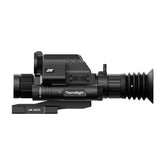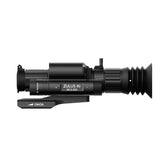Embracing the Future: How the DNT TNC335R ThermNight Has Transformed My Work as a Red Squirrel Ranger
This article was written by Jerry Moss, a seasoned red squirrel ranger. We’re excited to share his story.
A Reluctant Shift from Tradition
For years, my work as a red squirrel ranger has revolved around a traditional rifle scope. The clarity, precision, and familiarity of glass optics made them my trusted companion in the woods. Even though I had long relied on a thermal monocular to scan the landscape, I hesitated to transition fully into thermal/digital sighting on my rifle. The doubt wasn’t about the effectiveness of thermal technology—I knew firsthand how invaluable it was for spotting wildlife—but rather about abandoning the precision I associated with traditional scopes.
However, after a few weeks of using the DNT TNC335R ThermNight, I can confidently say that my perspective has shifted dramatically. This multispectral scope has been nothing short of a game changer, allowing me to identify grey squirrels with greater accuracy and efficiency while enhancing my conservation efforts.

The Challenge of Identifying Grey Squirrels
Grey squirrels pose a significant threat to the native red squirrel population in the UK. Their dominance in woodland ecosystems often leads to displacement of redsand they also carry the squirrel pox virus that is fatal to the reds. In my role as a ranger, monitoring and managing grey squirrel numbers is crucial. Yet, tracking and identifying them—especially in dense foliage—has always been a challenge.
Traditional glass scopes, while sharp in daylight, often fail in low-light conditions or heavily wooded areas. The subtle movement of a grey squirrel among branches and dense undergrowth can easily be mistaken for a trick of the light or overlooked entirely. This is where thermal imaging offers a vital advantage—detecting heat signatures rather than relying on colour and contrast.

Switching to the ThermNight’s multispectral vision introduced an entirely new level of precision and confidence in my ability to detect grey squirrels. Using the ThermNight on thermal mode with Colour PIP (Picture in Picture) makes ID instant. If the day is sunny and as a result too much heat to use in thermal mode, I can switch to Digital colour screen to allow me to carry on using the same rifle.
Here are some of the standout features for me.
• Thermal Imaging for Quick Detection
• Digital Day/Night Vision for Enhanced Visibility: As dawn breaks or evening sets in, the scope provides crystal-clear imaging, allowing me to track movements with accuracy.
• Target Identification with Greater Confidence: No more guessing whether movement in the branches belongs to a grey squirrel or a red squirrel or other.

The biggest revelation has been how quickly I can acquire and confirm targets. In the past, even with a thermal monocular, I’d have to scan, switch back to my scope or binoculars and reassess—a process that was time-consuming and often led to missed opportunities. Now, everything is streamlined into one seamless workflow.
Looking back, my reluctance to move away from a traditional glass scope was understandable—but ultimately, unfounded. The DNT TNC335R ThermNight has certainly changed my thoughts.
For anyone in a similar position—hesitant to make the leap to thermal imaging—my advice is simple: give it a try. You may find, as I did, that it isn’t just an upgrade—it’s a necessary evolution in woodland wildlife conservation.







